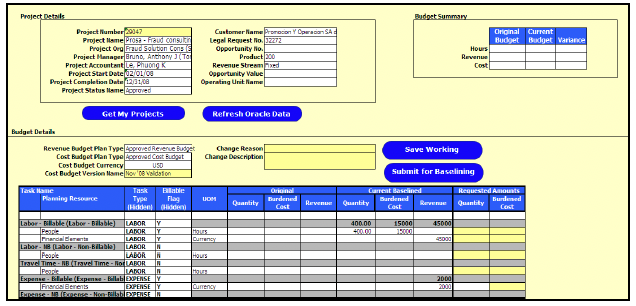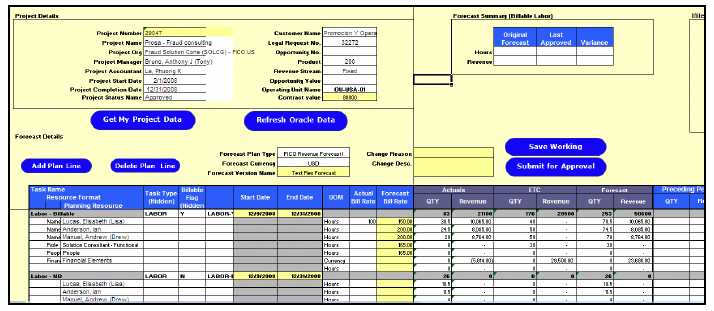Using Project Partners User Interface Applications™ to efficiently manage WBS, define budgets, and perform forecasting across Oracle E-Business Suite applications
The Situation
A leading financial Decision Management company specializing in credit scoring and business analytics, with global projects and users based in twelve countries, needed a globally integrated enterprise solution that could support their project-based business. Oracle E-Business Suite Projects Applications was the solution of choice. Oracle Project Costing and Oracle Project Billing were implemented to automate their project financials. Oracle Resource Management was implemented to manage their resources, ensuring the right resources are available at the right time and at the right internal cost to meet the demands of their client engagements. And Oracle Project Management was implemented to manage their robust project management needs.
With the wide range of functionality offered by Oracle Projects, the learning curve of navigating the Projects applications was quite steep, and the vast amount of navigation needed to perform simple tasks such as WBS maintenance, budgeting, and forecasting was becoming very cumbersome. Creating a budget and assigning resources using native Oracle Project Management and Oracle Resource Management can require over 20 screens of navigation to complete.
In addition, forecasts had not been integrated into Oracle Project Management and were being managed through a combination of off-line Microsoft Excel worksheets and Microsoft SharePoint, causing duplicate entry and data integrity issues, and the information was not integrated with Oracle Project Management for other project stakeholders to view. The ability to work while traveling, work from a client’s site, or work from a location without network connectivity is a must for project managers providing professional services as their main business. Time is critical, and information needs to be updated on a daily basis; quickly, easily, and efficiently.
This firm’s project managers needed a more integrated, easy-to-use collaborative entry model for task maintenance, budgeting, task-level progress collection, and Estimate-to-Complete forecasting that can be used from anywhere in the world, regardless of network connectivity. Their project managers required an easy solution to manage complex projects.
Why UI-Apps?
Based upon the needs of this Professional Services firm, UI-Apps quickly became the perfect solution for their project managers. UI-Apps were developed specifically for an end user – a project manager in this case – who needs to manage WBS, define budgets, and perform forecasting. UI-Apps worksheets were configured (by their IT staff requiring no special skills) to show only the data fields they wanted. The column names were changed to represent their terminology, the worksheets display their unique colors and layout, and were set up to follow the flow their project managers are accustomed to for their daily business operations.
This Professional Services firm implemented UI-Apps and rolled it out to their project managers worldwide in six short weeks. Feedback from their project managers was extremely positive:
“We like the small learning curve because we already know the interface – it is integrated, familiar and requires so many less clicks.”
Project Management User
Project Managers were able to quickly benefit from the Microsoft Excel-based interface with two-way interactivity to Oracle Applications and welcomed the ability to work in a disconnected mode from anywhere in the world.
Using UI-Apps, their project managers can now perform all of the following functions from one Microsoft Excel workbook:
- Create, Define, and Maintain Work Breakdown Structures, including indent and outdent capabilities and task modifications once saved
- Create, Define, and Maintain Project Workplans and Schedules
- Create, Define, and Maintain Budgets
- Collect Progress
- Review Project Costs/Actuals
- Complete Project Financial Forecasts
Time Phased Task and Budget Management
Project Managers are now able to use the Time Phased worksheet to manage their WBS and their budgets. Without navigating through the many financial planning HTML screens in Oracle, the WBS is created in UI-Apps or downloaded, if previously created in Oracle, directly into one familiar Excel worksheet. New tasks are added and maintained, and those tasks previously added can also be changed using this worksheet. The UI-Apps worksheets also integrate with their project work plans. Time Phased budgeting in UI-Apps allows their project managers to plan costs using fully burdened cost rates from Oracle and plan revenue using bill rates. Additionally, when forecasting, project managers forecast revenue using Oracle bill rates with the option for discounts or markups when necessary.

Using the Time Phased worksheet above, project managers select their desired project and plan type from the list of projects they have access. Tasks, budget lines, labor, and non-labor resources, along with their associated cost and bill rate information, are downloaded from Oracle directly into the worksheet for online and offline use. Once the project has been downloaded into the worksheet, the drop-down lists contain the lists of values associated with the project and are always available for use.
Task management options in this worksheet allow project managers to add or select tasks, add associated task attributes and task information, maintain WBS by indenting and outdenting the task location in the structure, and add both labor and non-labor resources to the budget plan. After selecting tasks and resources, the project manager can enter the quantities for labor and expenses. The associated cost and bill rates have already been downloaded with the project and can be overridden if necessary. Total plan amounts are entered and totaled for each period individually or are automatically spread across all periods within the task and resource dates of the project.
Additionally, the Time Phased worksheets support Oracle Project Management-defined period profiles, allowing data display data of up to 36 time periods, with additional periods for longer projects being grouped into preceding and succeeding periods. Project managers can adjust their view of the project’s periods by simply changing the current planning date, and the worksheet will automatically display this preferred view.
Once any changes have been made or the budget is complete, project managers have the option of saving the plan as a working version or submitting the budget for baseline. UI-Apps automatically follow the workflow rules set forth by their business processes.
Upon submission, UI-Apps perform the following actions using Oracle’s public APIs:
- Create tasks with all required attributes, i.e. transaction controls, task status, billable flags, chargeable flags, service type, etc.
- Create and define the budget with resources, quantities, and amounts
- Update the project work plan and publish the work plan
- Submit the budget for approval – working or baseline
- Attach a copy of the spreadsheet to the project
For future budget updates, the project manager simply makes changes to the worksheets stored on their local desktop or laptop and resubmits the data, which would update and submit the current working version of the budget to establish a new baseline. Alternatively, if the project manager has not retained the original workbook, they have the option for a new Excel file to be started, and the project, WBS, and budget information are downloaded once again to make changes as needed.
UI-Apps allow their users to download their project budget or forecast for review or update. If the project has already been downloaded for the update, UI-Apps will lock the worksheet and prevent updates to the worksheet while in use by other users. The project budget or forecast is always available to download for review by other project managers. Project managers can also save their budget (and/or forecast) and attach it to their project in Oracle as a project attachment.
Once the budget has been baselined, project managers can choose to have their forecast automatically generated from the approved cost budget and downloaded to the worksheet or generate the forecast from their prior forecasts.
Time Phased Forecasting
Using the Time Phased Forecasting worksheet is a real timesaver for this firm; no longer are they performing double entry between offline non-integrated Excel spreadsheets and SharePoint, but they are now working in one fully integrated workbook configured exactly to the way they do business. The result of UI-Apps forecasting implementation resulted in significant cost reductions and much more accurate project forecasts. The Forecasting worksheet allows their project managers to:
- Review Project Costs/Actuals
- Enter Estimate- to-Complete and Forecast (EAC) Values
- Review Project Budget and Forecast Variances
- Review Revenue Margins and Margin Percents
- Submit New Financial Forecasts
- Optionally Attach Forecasts as Attachments to the Project in Oracle

For each forecasting period, project managers download the latest information for their projects, including actual cost information (read-only) from Oracle, into the Forecasting worksheet. Estimate-to-Complete (ETC) amounts are calculated by default from the displayed budget amounts, but project managers always have the option for overrides if desired. ETC values default into the worksheet from different sources – approved budget, prior forecast, and the standard Oracle-generated ETC values. ETC amounts and work plan progress are also updated by the user at the task and/or resource level for existing tasks or for new tasks and/or resources. These values are entered once and integrated with the work plan. Percent complete and ETC amounts from the forecast and resource assignments are also integrated right into the work plan.
The configurability of UI-Apps allows their users to combine variations of the budgeting and forecasting worksheets into different workbooks to meet the demands of different business processes throughout various departments within the company. UI-Apps worksheets also provide summary data for project managers to quickly view their budget and forecast variances along with their revenue margin and margin percentages. At any given time, project managers have access to the latest information regarding their projects and can make any necessary changes “on the go” and submit those changes back to Oracle once they can connect to their network.
The ease of UI-Apps keeps their project managers focused on managing their projects rather than time-consuming, multi-page, multi-step data entry. Timely project information is crucial and is only kept up to date if it can be maintained quickly and efficiently.
In Conclusion
UI-Apps is an application suite delivering easy-to-use, easily tailored Microsoft Excel worksheets pre-configured to work with Oracle Projects Applications. UI-Apps provide an out-of-the-box solution for Professional Services. UI-Apps workbooks provide a user-friendly front-end that meets industry business needs while seamlessly integrating with Oracle security and business logic. It also provides business users with an intuitive way to accomplish complex tasks using a familiar yet powerful tool: Microsoft Excel. Watch this video series to learn more.